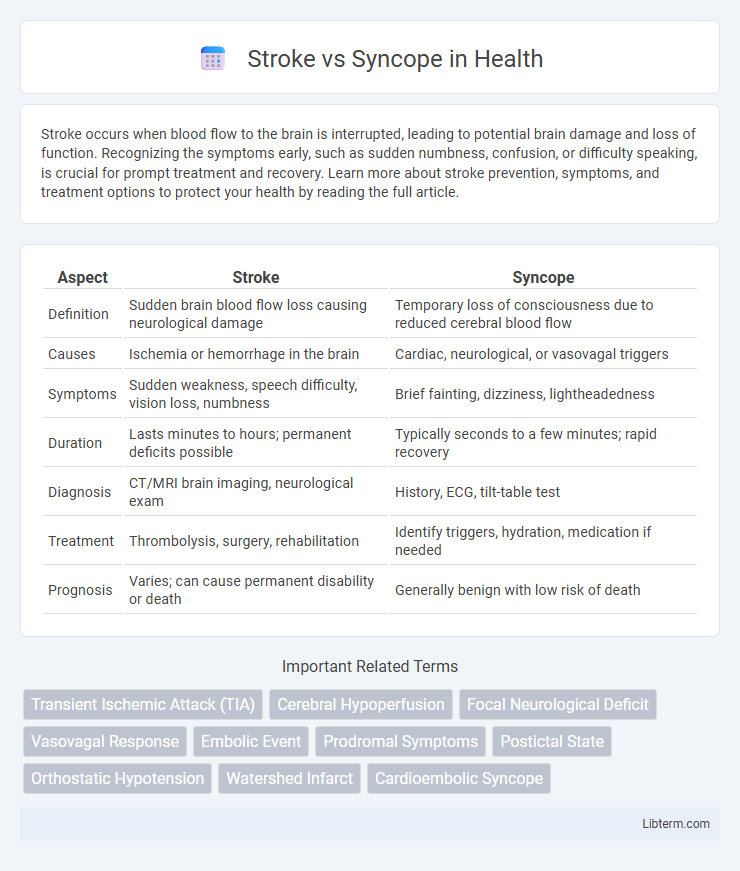Stroke occurs when blood flow to the brain is interrupted, leading to potential brain damage and loss of function. Recognizing the symptoms early, such as sudden numbness, confusion, or difficulty speaking, is crucial for prompt treatment and recovery. Learn more about stroke prevention, symptoms, and treatment options to protect your health by reading the full article.
Table of Comparison
| Aspect | Stroke | Syncope |
|---|---|---|
| Definition | Sudden brain blood flow loss causing neurological damage | Temporary loss of consciousness due to reduced cerebral blood flow |
| Causes | Ischemia or hemorrhage in the brain | Cardiac, neurological, or vasovagal triggers |
| Symptoms | Sudden weakness, speech difficulty, vision loss, numbness | Brief fainting, dizziness, lightheadedness |
| Duration | Lasts minutes to hours; permanent deficits possible | Typically seconds to a few minutes; rapid recovery |
| Diagnosis | CT/MRI brain imaging, neurological exam | History, ECG, tilt-table test |
| Treatment | Thrombolysis, surgery, rehabilitation | Identify triggers, hydration, medication if needed |
| Prognosis | Varies; can cause permanent disability or death | Generally benign with low risk of death |
Introduction to Stroke and Syncope
Stroke is a medical emergency characterized by the sudden loss of brain function due to interrupted blood supply, leading to neurological deficits. Syncope refers to a temporary loss of consciousness caused by a transient reduction in cerebral blood flow, usually followed by a rapid recovery. Differentiating stroke from syncope is critical for timely diagnosis and treatment, as both conditions present with distinct pathophysiology and clinical management protocols.
Defining Stroke: Causes and Risk Factors
Stroke results from an interruption of blood flow to the brain, caused by ischemic events such as blood clots or hemorrhagic events like ruptured blood vessels. Key risk factors include hypertension, atrial fibrillation, diabetes, smoking, and high cholesterol, which damage blood vessels or increase clot formation. Early identification of these factors is critical for stroke prevention and effective management.
Understanding Syncope: Types and Triggers
Syncope, characterized by a temporary loss of consciousness due to decreased cerebral blood flow, differs fundamentally from stroke, which involves permanent neurological damage from disrupted brain circulation. Common types of syncope include vasovagal, situational, and orthostatic, each triggered by factors such as stress, dehydration, prolonged standing, or sudden postural changes. Recognizing these triggers is crucial for accurate diagnosis and management, helping to prevent misinterpretation as stroke symptoms and ensuring appropriate treatment.
Key Differences Between Stroke and Syncope
Stroke involves a sudden disruption of blood flow to the brain causing neurological deficits, while syncope is a transient loss of consciousness due to temporary cerebral hypoperfusion. Key differences include the duration and recovery: stroke symptoms persist and worsen without intervention, often causing lasting damage, whereas syncope results in rapid, spontaneous recovery. Diagnostic tools such as brain imaging (CT or MRI) are critical for stroke identification, whereas syncope is often evaluated through cardiovascular tests like ECG and tilt-table testing.
Clinical Presentation: Signs and Symptoms
Stroke typically presents with sudden onset of focal neurological deficits such as unilateral weakness, facial droop, speech difficulties (aphasia or dysarthria), and visual disturbances, alongside possible headache or altered consciousness. Syncope is characterized by a transient loss of consciousness with rapid onset, brief duration, and spontaneous complete recovery, often accompanied by prodromal symptoms like dizziness, nausea, or sweating without focal neurological signs. Distinguishing features include persistent neurological deficits in stroke versus full neurological recovery after syncope.
Diagnostic Approaches for Stroke and Syncope
Differentiating stroke from syncope requires targeted diagnostic approaches, including neuroimaging like MRI or CT scans to identify ischemic or hemorrhagic brain lesions characteristic of stroke, while syncope evaluation prioritizes cardiovascular assessment such as ECG, Holter monitoring, and tilt-table testing to detect arrhythmias or orthostatic hypotension. Comprehensive neurological examination combined with detailed patient history focusing on symptom onset, duration, and associated features enhances diagnostic accuracy. Biomarkers such as elevated serum neuron-specific enolase or S100B protein can support ischemic stroke diagnosis, whereas syncope lacks specific serum markers and relies more on clinical context and cardiac evaluation.
Emergency Management: Initial Steps
Emergency management of stroke prioritizes rapid identification and activation of stroke protocols, including immediate neuroimaging and administration of thrombolytic therapy within the therapeutic window. Syncope management focuses on assessing airway, breathing, and circulation, ruling out life-threatening causes such as cardiac arrhythmias through ECG monitoring and bedside evaluation. Both conditions require prompt stabilization, but stroke demands urgent neurologic assessment while syncope necessitates cardiovascular evaluation to determine underlying etiology and guide treatment.
Treatment Strategies for Stroke vs Syncope
Treatment strategies for stroke prioritize rapid restoration of cerebral blood flow through thrombolytic therapy, mechanical thrombectomy, and secondary prevention with antiplatelet or anticoagulant medications. Syncope management focuses on identifying and treating the underlying cause, such as dehydration, arrhythmias, or vasovagal episodes, often involving lifestyle modifications, hydration, or cardiac monitoring. Stroke requires immediate neurovascular intervention, while syncope treatment is typically targeted at symptom control and underlying condition stabilization.
Prevention and Long-term Care
Effective stroke prevention involves managing hypertension, controlling diabetes, maintaining a healthy diet, and regular physical activity to reduce vascular risk factors. Long-term care after stroke emphasizes rehabilitation therapies, cognitive and speech therapy, and secondary stroke prevention strategies like antiplatelet or anticoagulant medications. Syncope prevention focuses on identifying and treating underlying causes such as arrhythmias or orthostatic hypotension, alongside lifestyle modifications; long-term care includes monitoring and managing recurrent episodes to minimize injury risk and improve quality of life.
When to Seek Immediate Medical Attention
Seek immediate medical attention for stroke symptoms such as sudden numbness or weakness on one side of the body, difficulty speaking, confusion, vision problems, severe headache, or loss of balance. Syncope, or fainting, requires urgent evaluation if accompanied by chest pain, irregular heartbeat, shortness of breath, head injury, or if the person has a history of heart disease. Rapid medical intervention is critical to prevent permanent brain damage in stroke and to identify life-threatening causes of syncope.
Stroke Infographic

 libterm.com
libterm.com